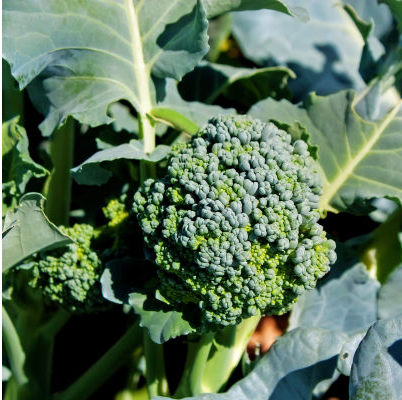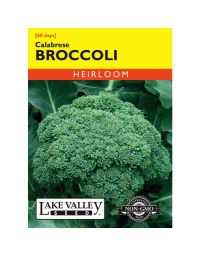Broccoli is a hardy vegetable of the cabbage family that is high in vitamins A and D. It develops best during cool seasons of the year.

Broccoli (Brassica oleracea var. italica) is an important green vegetable in Minnesota. Small, edible floral shoots make up a broccoli plant’s head. You can eat the tender, bright green flower stalks and undeveloped flowers raw as part of a vegetable platter, or chopped and mixed into a salad or slaw. Some prefer broccoli cooked in a soup or in a savory sauté, as well as stir-fried or steamed as a side dish.
The leaves of broccoli plants are edible. Use them as you would kale or collards. Some varieties have purple coloring when raw. This coloring usually fades, leaving a bright green hue after cooking. More information can be found on the University of MN Ext. Website.
Transplants are recommended to give the best start for spring planting. Fall crops may be direct-seeded in the garden if space allows or may be started in flats to replace early crops when their harvest ends.
When to Plant
- Transplant young, vigorously growing plants in early spring.
- Plants that remain too long in seed flats may produce "button" heads soon after planting.
- For fall crops, buy or grow your own transplants or plant seeds directly in the garden.
- For fall planting, start seedlings in midsummer for transplanting into the garden in late summer.
- To determine the best time for setting your fall transplants, count backward from the first fall frost in your area and add about 10 to the days to harvest from transplants. Remember that time from seed to transplant is not included in this figure.
Spacing & Depth
- Plant seeds 1/4 to 1/2 inch deep, or set transplants slightly deeper than they were grown originally.
- Plant or thin seedlings 18 to 24 inches apart in the row and allow 36 inches between rows.
- Broccoli plants grow upright, often reaching a height of 2 1/2 feet. S
- pace plants one foot apart in all directions in beds.
Care
- Use starter fertilizer for transplants and side-dress with nitrogen fertilizer when the plants are half grown.
- Provide ample soil moisture, especially as the heads develop.
Harvesting
- The edible part of broccoli are compact clusters of unopened flower buds and the attached portion of stem.
- The green buds develop first in one large central head and later in several smaller side shoots.
- Cut the central head with 5 to 6 inches of stem, after the head is fully developed, but before it begins to loosen and separate and the individual flowers start to open (show bright yellow).
- Removing the central head stimulates the side shoots to develop for later pickings.
- These side shoots grow from the axils of the lower leaves.
- You may continue to harvest broccoli for several weeks.
Common Problems
- Aphids — Watch for buildup of colonies of aphids on the undersides of the leaves.
- Cabbage worms — Three species of cabbage worms (imported cabbage worms, cabbage loopers and diamond back moth worms) commonly attack the leaves and heads of cabbage and related cold crops.
The Gerten Experts are always available to answer your questions!



